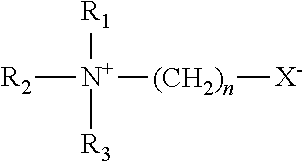Betaine Enhancement of Fermentation to make C4 Diacids
a technology of enhancing fermentation and betaine, which is applied in the direction of biochemistry apparatus and processes, peptides, microorganisms, etc., can solve the problems of uneconomical use of large-scale industrial fermentation, relatively expensive nutrient sources, and yeast extract, so as to reduce productivity, reduce production, and eliminate commercial yeast extract.
- Summary
- Abstract
- Description
- Claims
- Application Information
AI Technical Summary
Benefits of technology
Problems solved by technology
Method used
Image
Examples
Embodiment Construction
[0015]Disclosed herein is an improved method of fermenting a microorganism to produce a C4 diacid, which improvement utilizes a betaine in the fermentation medium to eliminate or reduce the need for expensive media components such as yeast extract, and which can more than double the titer, yield and productivity rate from such less expensive media in comparison to the same media lacking the betaine. The need for using yeast extract was abolished and could be substituted with corn steep liquor and betaine and optionally with mono sodium glutamate, while achieving similar or better C4 diacid production parameters as were previously obtained in media requiring yeast extract. The savings in material reduces the overall cost of (A diacid production by 5 fold in comparison to use of yeast extract containing media.
[0016]A betaine is a zwitterionic quaternary amine compound having the general structure:
where R1, R2 and R3 are typically small aliphatic groups that are usually the same but wh...
PUM
| Property | Measurement | Unit |
|---|---|---|
| Fraction | aaaaa | aaaaa |
| Fraction | aaaaa | aaaaa |
| Fraction | aaaaa | aaaaa |
Abstract
Description
Claims
Application Information
 Login to View More
Login to View More - R&D
- Intellectual Property
- Life Sciences
- Materials
- Tech Scout
- Unparalleled Data Quality
- Higher Quality Content
- 60% Fewer Hallucinations
Browse by: Latest US Patents, China's latest patents, Technical Efficacy Thesaurus, Application Domain, Technology Topic, Popular Technical Reports.
© 2025 PatSnap. All rights reserved.Legal|Privacy policy|Modern Slavery Act Transparency Statement|Sitemap|About US| Contact US: help@patsnap.com

